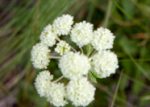 Lyall’s angelica is a herbaceous perennial and a member of the parsley family, Apiaceae, that also includes carrots, celery, and Queen Anne’s lace. It is native to western North America where it grows in meadows, marshes, bottomlands, along streams, and in montane zones from Alaska, south to Wyoming and California. Growing 2-7′ tall from a large often divided taproot, the plant has a stout, hallow, vertically ribbed stem and alternate somewhat triangular leaves that sheath the stem. Each leaf is divided into eliptacal to lanceolate, sharply toothed leaflets 2-6″ long and has a pungent parsley or celery scent when crushed. From late spring to mid summer small white to pinkish flowers appear in large flat-topped compound umbels. The genus name, Angelica, is the feminine form of the late Latin word angelicus and alludes to the supposed magical properties associated with the plant. The specific epithet, arguta, means toothed and refers to the margins of the leaves.
Lyall’s angelica is a herbaceous perennial and a member of the parsley family, Apiaceae, that also includes carrots, celery, and Queen Anne’s lace. It is native to western North America where it grows in meadows, marshes, bottomlands, along streams, and in montane zones from Alaska, south to Wyoming and California. Growing 2-7′ tall from a large often divided taproot, the plant has a stout, hallow, vertically ribbed stem and alternate somewhat triangular leaves that sheath the stem. Each leaf is divided into eliptacal to lanceolate, sharply toothed leaflets 2-6″ long and has a pungent parsley or celery scent when crushed. From late spring to mid summer small white to pinkish flowers appear in large flat-topped compound umbels. The genus name, Angelica, is the feminine form of the late Latin word angelicus and alludes to the supposed magical properties associated with the plant. The specific epithet, arguta, means toothed and refers to the margins of the leaves.
Type: Herbaceous perennial
Bloom: Flat topped compound umbels of small white to pinkish flowers in late spring
Size: 2-7′ H
Light: Full sun to part shade
Soil: Average, moist
Hardiness: Zones 4-8
Care: Low maintenance
Pests and Diseases: None of significance
Propagation: Seed, division, offshoots
Companion Plants: Columbine, lily, helenium